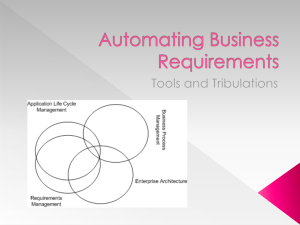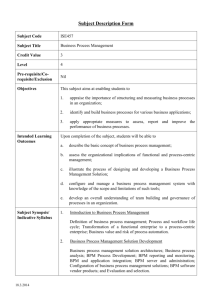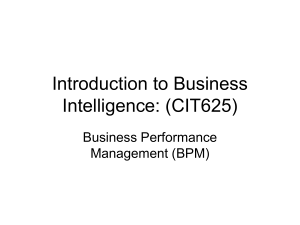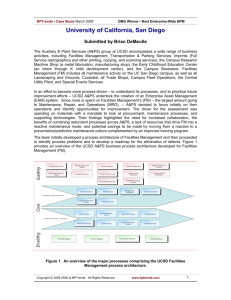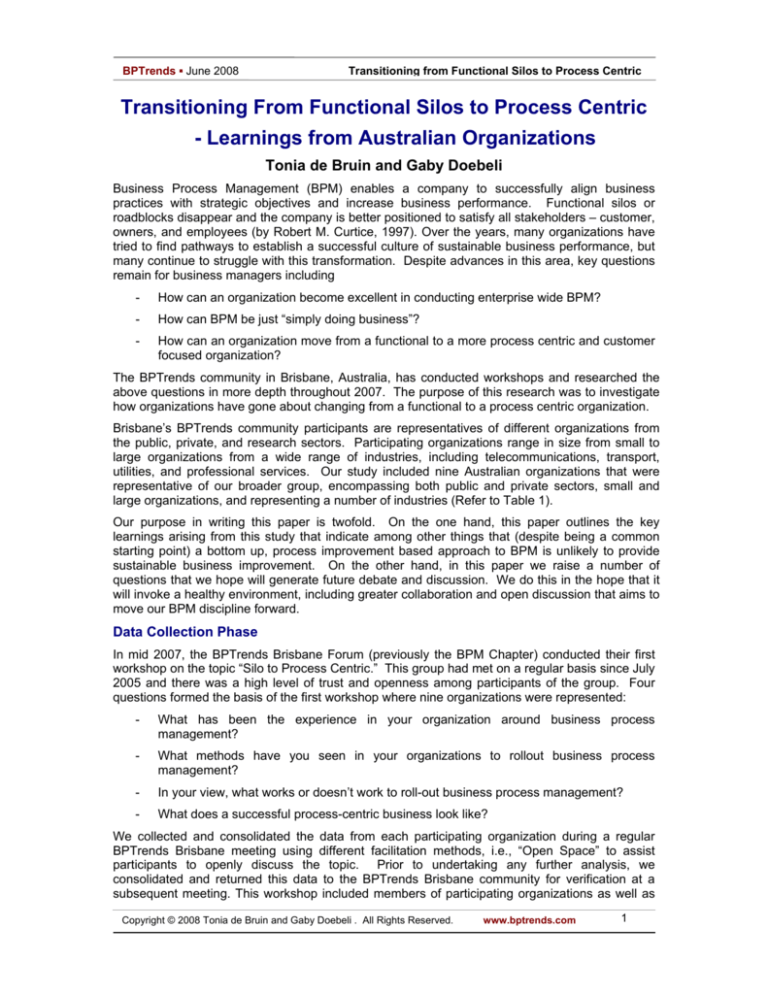
BPTrends ▪ June 2008
Transitioning from Functional Silos to Process Centric
Transitioning From Functional Silos to Process Centric
- Learnings from Australian Organizations
Tonia de Bruin and Gaby Doebeli
Business Process Management (BPM) enables a company to successfully align business
practices with strategic objectives and increase business performance. Functional silos or
roadblocks disappear and the company is better positioned to satisfy all stakeholders – customer,
owners, and employees (by Robert M. Curtice, 1997). Over the years, many organizations have
tried to find pathways to establish a successful culture of sustainable business performance, but
many continue to struggle with this transformation. Despite advances in this area, key questions
remain for business managers including
-
How can an organization become excellent in conducting enterprise wide BPM?
-
How can BPM be just “simply doing business”?
-
How can an organization move from a functional to a more process centric and customer
focused organization?
The BPTrends community in Brisbane, Australia, has conducted workshops and researched the
above questions in more depth throughout 2007. The purpose of this research was to investigate
how organizations have gone about changing from a functional to a process centric organization.
Brisbane’s BPTrends community participants are representatives of different organizations from
the public, private, and research sectors. Participating organizations range in size from small to
large organizations from a wide range of industries, including telecommunications, transport,
utilities, and professional services. Our study included nine Australian organizations that were
representative of our broader group, encompassing both public and private sectors, small and
large organizations, and representing a number of industries (Refer to Table 1).
Our purpose in writing this paper is twofold. On the one hand, this paper outlines the key
learnings arising from this study that indicate among other things that (despite being a common
starting point) a bottom up, process improvement based approach to BPM is unlikely to provide
sustainable business improvement. On the other hand, in this paper we raise a number of
questions that we hope will generate future debate and discussion. We do this in the hope that it
will invoke a healthy environment, including greater collaboration and open discussion that aims to
move our BPM discipline forward.
Data Collection Phase
In mid 2007, the BPTrends Brisbane Forum (previously the BPM Chapter) conducted their first
workshop on the topic “Silo to Process Centric.” This group had met on a regular basis since July
2005 and there was a high level of trust and openness among participants of the group. Four
questions formed the basis of the first workshop where nine organizations were represented:
-
What has been the experience in your organization around business process
management?
-
What methods have you seen in your organizations to rollout business process
management?
-
In your view, what works or doesn’t work to roll-out business process management?
-
What does a successful process-centric business look like?
We collected and consolidated the data from each participating organization during a regular
BPTrends Brisbane meeting using different facilitation methods, i.e., “Open Space” to assist
participants to openly discuss the topic. Prior to undertaking any further analysis, we
consolidated and returned this data to the BPTrends Brisbane community for verification at a
subsequent meeting. This workshop included members of participating organizations as well as
Copyright © 2008 Tonia de Bruin and Gaby Doebeli . All Rights Reserved.
www.bptrends.com
1
BPTrends ▪ June 2008
Transitioning from Functional Silos to Process Centric
members from non-participating organizations, including different sector organizations as well as
Universities and Consultancies.
Details of the nine organizations that participated in this research are included in Table 1.
Company
Sector
Industry
Company Size
(employees)
Year BPM Started
1
Private
Telecommunications
Approx
FTE
Owners
35,000 Process
appointed in 1997
with ongoing partial
variations
of
Business Process
Management
implemented during
intervening years.
[i.e., CMMI Level 2]
2
Government
Owned
Transport / Logistics
Approx
FTE
14,000 1996?
3
Government
Owned
Utilities
800 FTEs
Started in 1999,
although we didn't
know at the time
that's what it was;
started calling it BPI
in 2004.
4
Government
Owned
Banking and Finance
400 FTEs
Not identified
5
Public
Government (state)
2200 FTE
Conception 2007
6
Council
Government (local)
7000 FTE
Business
Process
Improvement started
in 2000 and got
formal
with
a
corporate process in
2002.
7
Public
Government (state)
3594 FTE
Started
actively
Modeling/Innovations
since 2004
8
Consultancy
Professional Services
2000 people
2005
9
GOC
Utilities
5000 FTEs
1 July 1999
Table 1. Demographics of Participating Organizations
Copyright © 2008 Tonia de Bruin and Gaby Doebeli . All Rights Reserved.
www.bptrends.com
2
BPTrends ▪ June 2008
Transitioning from Functional Silos to Process Centric
Data Analysis Phase
Following the two rounds of data collection, we formed a small analysis team from the BPTrends
Forum to analyze and report on the data. The team included a Business Architect, a Six Sigma
Black Belt, and a PhD student. The Business Architect was from a participant organization. The
Six Sigma Black Belt was from a non-participant organization. The PhD student was from a nonparticipant organization, experienced in research into BPM in organizations and highly
experienced in analyzing qualitative data.
This team first independently categorized the data before coming together to review and
consolidate classifications. The analysis team entered the categorizations from the analysis team
into a database containing all data from the study prior to conducting a series of shuffle tests. For
the shuffle tests, the analysis team transferred both the categories they had determined and the
individual items to shuffle cards. The analysis team selected an individual from a participating
organization with experience in BPM for the first shuffle test. The participant received the shuffle
cards separated into the categories and the items, and the analysis team asked that she place
each item into the appropriate category. The participant was encouraged to provide comment
during the process and to ask questions of the analysis team as required. The analysis team
recorded the outcomes of the classification into the database. Following the first shuffle test, the
analysis team reconsidered the classification and amended the categories as required.
The analysis team conducted the second shuffle test with all members at the next BPTrends
Forum to confirm the categories. This included members of both participating and nonparticipating organizations. The approach taken in the workshop was to split attendees into three
groups. Members’ details and comments were captured within each group to enable the analysis
team to clarify any issues with the groups during later data analysis, if required. Each group
received the category and item cards and were asked to undertake their own classification,
placing all items into one of the categories provided. Members were encouraged to write down
comments on any issues they encountered. At the completion of the placements, the analysis
team collected all cards and sealed them in envelopes corresponding to the categories from each
team. The analysis team later opened these envelopes, and the categorizations were transferred
to the consolidated database for further analysis.
Following the shuffle tests, the analysis team discussed how best to analyze the next round of
data as there were five rounds of categorized data in total. Rules were set to guide the analysis
team in the next phase of analysis. The data was split among members of the analysis team due
to time constraints, and each analyst applied the rules separately to the data before swapping
analysis with each other for review.
Following the comments provided by the members of the BPTrends Forum, the analysis team was
able to consolidate a number of the categories and construct definitions of all the final categories.
Where 4 out of 5 placements were for the same category, the item was placed into that category.
Where placements did not strongly match a single category the analysis team reviewed the
comments, the categorization from each group, and revisited the initial data in light of the
proposed definitions. If this resulted in clarification of placement, the item was duly categorized
and a comment regarding the placement was noted in the database, elaborating in detail how we
reached the decision. If this did not result in clarification, the item was flagged for discussion with
other members of the analysis team. Where the analysis team was unable to reach a common
view on a categorization, the item was referred back to the initiating organization for placement.
The analysis team presented the data back to the BPTrends Forum for review and comments at
the end of the analysis. All participating organizations were asked to verify and confirm the
placement of their items in light of the final categories and their definitions.
While the data collected covered a number of aspects of the journey from silo to process centric,
this paper focuses and presents the lessons learned.
Copyright © 2008 Tonia de Bruin and Gaby Doebeli . All Rights Reserved.
www.bptrends.com
3
BPTrends ▪ June 2008
Transitioning from Functional Silos to Process Centric
Findings
In this paper, we present the findings from our study, being the “Lessons Learned” during the
organization’s journey from a functionally driven to a process driven organization. In total, 16
items were recorded in this section of our study. Our coding process to classify the data items
identified four categories of BPM Approach, BPM Skills and Expertise, Executive Buy-In, and
Organizational Culture. The category that captured most lessons was that of BPM Approach with
50% of all items recorded. We classified the remaining 50% of items into categories of BPM Skills
and Expertise, Executive Buy-In, and Organizational Culture. Table 2 shows the categories of
Lessons Learned together with the definitions we derived for each category and the number of
items we allocated to each category.
Category
Definition
Items
Allocated
BPM Approach
The manner in which the organization is going about
establishing BPM; e.g., this may include a top-down or
bottom up approach or it may include using a centralized
BPM.
8
BPM Skills and
Expertise
The availability and accessibility the organization has to
appropriate process skills and expertise.
3
Executive Buy-in
The demonstration and commitment executives and
senior management show to BPM within the organization.
2
Organizational
Culture
The culture within the organization as it pertains to BPM,
including the attitudes and behaviors of individuals and
groups.
3
Table 2. Learnings from Research
The following sections expand on the categories and the items placed within them.
BPM Approach
Without a doubt, the single biggest area in which organizations identified lessons learned was in
their approach to BPM. Our study showed that the documented learning relating to the BPM
Approach was the result of a negative experience with the BPM Approach they had tried. On the
positive side, in every case, the organizations worked to adjust their approach and continue with
BPM itself. This suggests that, within our study, the commitment to BPM remains, despite not
having success in the first instance.
The organizations in our study were predominately from the public sector, including a number of
government-owned organizations. A smaller number were from the private sector, including
industries of finance and insurance. Only one private sector organization reflected learnings with
regard to its BPM Approach. All remaining items pertaining to the category of BPM Approach
were from public sector organizations.
The items we classified to the BPM Approach category were
-
Current view is that the approach to transition from silo to process-centric will be a longterm and incremental.
-
It is a journey.
-
Isolated successes within some functional groups via a “top down” approach.
-
Need different approaches, depending on the drivers and type of initiative.
-
Shared Services are more advanced in being “process-centric” because they have
always needed to approach the business in an integrated way.
Copyright © 2008 Tonia de Bruin and Gaby Doebeli . All Rights Reserved.
www.bptrends.com
4
BPTrends ▪ June 2008
Transitioning from Functional Silos to Process Centric
-
Temporary success with Six Sigma (isolated improvement initiatives not end-to-end) was
unsustainable.
-
The method (bottom up, isolated improvement initiative approach) was a start; however,
it did not add great value to the end-result of the organization.
-
This method (i.e., IT only focus) was not successful.
When talking about the approach to BPM, organizations in our study identified approaches that
we classified along two spectrums. On the one hand, there was the traditional top down or
bottom up approach. On the other hand, there was the centralized or de-centralized approach
with organizations opting to have a BPM Centre or Team or not.
All organizations participating in our research applied the bottom-up approach at one point in
time. Despite this, none found this approach to be successful in achieving a change from
functional to process driven organization. In fact, our study suggests that a bottom-up approach
to implementing BPM capabilities in an organization offers little or no (long-term) success. A
number of organizations indicated that the change from a functional silo to more process centric
thinking requires a long-term strategy; hence, organizations talk about the “Journey of BPM.”
One organization that started with BPM as a company-wide initiative indicated that using just Six
Sigma provided some short-term improvement, but that this was unsustainable in the long term.
Such comments support emerging views that enduring BPM is about more than a co-ordinated
program of process improvement projects, even ones using well-recognized and widely applied
methods. Interestingly, this same organization indicated that its organizational structure was a
significant challenge in its BPM journey. One could suggest then that methods, such as Six
Sigma, are potentially insufficient for addressing cultural issues especially those arising in a
functionally structured organization.
In another organization, an independent, centralized team was driving the BPM initiative. This
team focused on process improvement, leveraging off technology projects to identify quick wins
for the business area. The organization had recognized top-down support for major technology
initiatives such as implementation of new ERP systems. The organization adopted a bottom-up
approach for smaller initiatives where process improvement aimed at addressing recognized pain
points. Despite this, the organization found a challenge engaging the business. They felt they
did not do this early enough and recognized that they had different cultures within different
business groups. This situation highlights the importance of people and culture to the way in
which an organization approaches BPM. Top down support, in itself, is not sufficient but
responding to known areas of pain (whilst being a well-recognized approach to BPM) does not
necessarily lead to the required transformation within businesses. This organization suggested
matching the BPM approach to the business drivers and the type of initiative when transforming
from a functional to process organization.
A number of organizations displayed iterative approaches to BPM where they started with a
bottom up approach, found that it did not work, experienced a period of reflection that led to a
change in tact and a move to a different approach. These organizations were fortunate enough
to have continuing support through a number of BPM incarnations. In all cases these companies
moved away from focusing on the individual methods or IT tools, i.e., process modeling, Six
Sigma, and started to consider other factors like Strategic Alignment, People, and Culture. These
organizations reflected on the importance of having executive buy-in to their BPM initiatives.
Another finding was that most of the organizations that indicated a change in their BPM approach
experienced challenges with the organizational structure and fluctuating levels of executive buyin.
Such comments provide a number of important insights for organizations looking to BPM as a
new approach to managing their business. On the one hand, organizations need to commit to
BPM over a long term. At the same time however, they also need to recognise that the first
attempts are unlikely to be lasting. This in itself presents a significant paradox both to the
organizations and to the BPM discipline. For example, many organizations are constrained in
their BPM Approach by an inability to gain senior executive sponsorship and commitment. The
Copyright © 2008 Tonia de Bruin and Gaby Doebeli . All Rights Reserved.
www.bptrends.com
5
BPTrends ▪ June 2008
Transitioning from Functional Silos to Process Centric
inability to articulate ROI (return on investment) on the intangible but essential elements of BPM
such as cultural change and employee behavior, drive these organizations to focus on more
tangible process improvement projects such as the implementation of new technology to gain
executive support and commitment. Any failure in the resultant projects only serves to reinforce
sceptics in their belief that BPM is no good. However, any success in resultant projects fuels the
short-term fire, thus making it still difficult to argue the longer-term view. Despite this, we have
seen evidence in our organizations that the short-term approach, even when it does deliver
benefits, does not deliver sustainable improvement within an organization.
The majority of organizations participating in this research experienced some early success in the
implementation of methods such as Six Sigma or in using business process modeling tools.
Despite this, none of the organizations felt that they have achieved a sustainable change from a
silo to a process culture. This indicates that an organization can have the best Process Analysts,
adopt recognized process improvement methods and IT tools, and still not achieve a successful
shift from a functional to a process driven organization.
Our study shows that a bottom-up, process improvement based approach to BPM does not lead
to sustainable business improvement, no matter that it may be organization wide. Similarly, a
top-down approach in itself is insufficient to guarantee success when driven by a centralized team
that struggles to engage the rest of the organization. We would raise the following question for
further contemplation:
How do we get organizations to engage in the long-term commitment to BPM that is required to
deliver sustainable business improvement?
Skills and Expertise
The categories of BPM Skills and Expertise and Organizational Culture received the next highest
number of items in which organizations identified lessons learned. We consider the availability
and accessibility the organization has to the appropriate skills and expertise in this section. The
items classified to this category included
-
Encyclopaedia Management is required.
-
Levelling (i.e., Process model levels) is difficult to explain.
-
Skilled, experienced process analysts are hard to find.
All items identified in this category related to learnings around process modeling and analysis at
an operational level. This is not surprising considering our earlier insights into the BPM Approach
whereby all organizations started with a bottom-up approach, choosing to focus on process
modeling and improvement initiatives rather than adopting a more strategic approach to BPM. By
looking specifically at the individual organizations that voiced their learnings within “Skills and
Expertise,” we confirmed this notion, with all organisations having adopted a bottom up and adhoc approach to the implementation of BPM. Furthermore, all organizations noted little or no
executive buy-in to the BPM initiative. A principle driver for these organizations was the desire to
capture process knowledge.
Arguably, another area of BPM Skills and Expertise that appears to be sadly lacking is that of
broader BPM understanding. While not actually raised by our participating organizations, the
common issues and lack of early success experienced in almost all of the companies, could
suggest a lack of knowledge and skills in implementing strategic BPM initiatives. Perhaps, if
more understanding of BPM existed in, or was available to, these organizations, they may not
have had so many false starts with their BPM journeys.
We would raise the following questions for further contemplation:
What BPM skills and expertise do we need to see developed?
How can we, as a community, best develop these?
Copyright © 2008 Tonia de Bruin and Gaby Doebeli . All Rights Reserved.
www.bptrends.com
6
BPTrends ▪ June 2008
Transitioning from Functional Silos to Process Centric
Organizational Culture
One organization reviewed their success and challenges in light of their people, their values, and
behaviors, leading to the identification of “Organizational Culture” as a significant learning. Over
time, and because of early learning, this team changed their BPM Approach from bottom-up and
fragmented to a more top-down, distributed approach. This single organization accounts for all
the items placed into this category being:
-
BPM is a team effort and requires collaboration, patience, and the ability to put yourself into
others positions, etc.
-
No room for EGOs.
-
We don’t yet seem to learn from our previous mistakes.
This organization found that to achieve a top-down approach and company-wide acceptance of
BPM, strong executive buy-in is required. For this organization, it took an ERP implementation
and a new CEO to enable a top-down and company-wide BPM focus. However, the BPM
momentum was lost after the ERP implementation and the project team closure. Only a small,
centralized team of process architects and analysts remained, with the support of a BPM
Community. This team did not have any strong support or commitment from the Senior Executive,
and soon BPM efforts occurred again in isolated pockets of the organization. The organization
soon found that without the buy-in and commitment of the Senior Executive and leadership
teams, a company-wide program was not sustainable.
The findings of this organization are consistent with the other companies that participated in this
study. Despite this, all the organizations in our study remain committed to progressing BPM, as
evidenced by their willingness to participate in this study and their continued support of the
BPTrends Forum participation and other similar community groups.
In a similar vein, in his book “Process Management is a Team Sport,” Andrew Spanyi says a
team needs a coach and a leader who is committed to his team and supports all players. Our
evidence supports the view that strong BPM leadership at a strategic and tactical level is
essential for long-term BPM efforts. Despite this, findings from our organizations also suggest
that BPM teams on their own are insufficient for sustainable BPM success, even those with high
levels of top management support. The question we would pose for further contemplation is
therefore:
Why are some BPM teams ineffective, even when they seemingly have top-level support?
Executive Buy-In
Finally, a number of organizations learned lessons relating to the levels of executive commitment
they had for BPM. Comments reflecting this sentiment included
-
Commitment to continuous improvement by Executive is essential.
-
Top-level support makes it so much easier.
Organizations that experienced learning in the Executive Buy-in category approached BPM using
a fragmented, bottom-up approach. A number of other participating organizations reported a
need to gain executive buy-in during their journey in order to overcome challenges. These
organizations progressed from an ad-hoc approach focusing on the methods and IT tools to
progress the journey. The majority of these organizations were from the public sector.
The question we would pose for further contemplation is therefore:
How can an organization increase executive buy-in to BPM?
Copyright © 2008 Tonia de Bruin and Gaby Doebeli . All Rights Reserved.
www.bptrends.com
7
BPTrends ▪ June 2008
Transitioning from Functional Silos to Process Centric
Conclusion
In this paper we have presented a subset of findings arising from a study of 9 organizations
seeking to change from a functional to a process driven organization. We have seen that a
bottom up, fragmented approach to BPM is rarely found to deliver sustainable business
improvement. Furthermore, we have found strong support for the role of executive buy-in to BPM
transformations. Despite this, we have found that for some organizations a BPM team with
strong executive support can be insufficient for sustainable practices.
We posed a number of questions that we hope will open debate in these areas. We reiterate
these questions here:
1. How do we get organizations to engage in the long-term commitment to BPM that is
required to deliver sustainable business improvement?
2. What BPM skills and expertise do we need to see developed and how (as a community)
can we best develop these?
3. Why are some BPM teams ineffective, even when they seemingly have top-level
support?
4. How can an organization increase executive buy-in to BPM?
If you would like to comment on these questions, we welcome emails to t.debruin@qut.edu.au or
g.doebeli@qr.qld.gov.au. Alternatively, we would encourage further discussion within the
BPTrends Forum.
Acknowledgements
The authors would like to acknowledge and thank the participants of the “Silo to Process” study
and the BPTrends (Brisbane) Forum participants for their insights and continued support.
Copyright
de Bruin, T and Doebeli, G © 2008. The authors assign BPTrends a non-exclusive licence to use
this document for personal use and in courses of instruction providing the full article is used and
this copyright statement is reproduced. Any other usage is prohibited without the express
permission of the authors.
Copyright © 2008 Tonia de Bruin and Gaby Doebeli . All Rights Reserved.
www.bptrends.com
8




